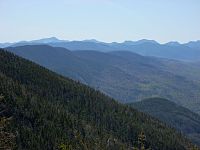
Photo from wikipedia
Determining forest structural complexity, i.e., a measure of the number of different attributes of a forest and the relative abundance of each attribute, is important for forest management and conservation.… Click to show full abstract
Determining forest structural complexity, i.e., a measure of the number of different attributes of a forest and the relative abundance of each attribute, is important for forest management and conservation. In this study, we examined the structural complexity of mixed conifer–broadleaf forests by integrating multiple forest structural attributes derived from airborne LiDAR data and aerial photography. We sampled 76 plots from an unmanaged mixed conifer–broadleaf forest reserve in northern Japan. Plot-level metrics were computed for all plots using both field and remote sensing data to assess their ability to capture the vertical and horizontal variations of forest structure. A multivariate set of forest structural attributes that included three LiDAR metrics (95th percentile canopy height, canopy density and surface area ratio) and one image metric (proportion of broadleaf cover), was used to classify forest structure into structural complexity classes. Our results revealed significant correlation between field and remote sensing metrics, indicating that these two sets of measurements captured similar patterns of structure in mixed conifer–broadleaf forests. Further, cluster analysis identified six forest structural complexity classes including two low-complexity classes and four high-complexity classes that were distributed in different elevation ranges. In this study, we could reliably analyze the structural complexity of mixed conifer–broadleaf forests using a simple and easy to calculate set of forest structural attributes derived from airborne LiDAR data and high-resolution aerial photography. This study provides a good example of the use of airborne LiDAR data sets for wider purposes in forest ecology as well as in forest management.
Journal Title: Journal of Forestry Research
Year Published: 2017
Link to full text (if available)
Share on Social Media: Sign Up to like & get
recommendations!